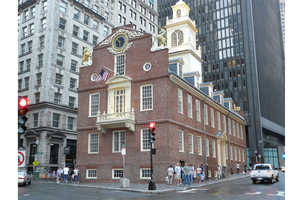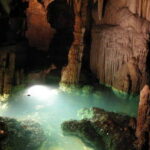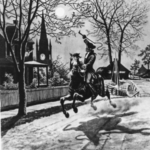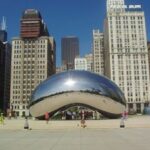One of the most famous walking tours in America is that of the Freedom Trail in Boston, Massachusetts. A red brick pathway leads you through and around downtown Boston and then to neighboring Charlestown in this two and a half mile, one-way, self-guided tour that takes you to sixteen of the most historically significant locations in the area. To walk the Freedom Trail is to connect with the very beginnings of this country.
The Freedom Trail’s stops are as follows:
1. Boston Common
The Trail starts off at the oldest public park in America, opened in 1634 as a common area for Boston farmers to graze their cattle. Over one thousand redcoats made camp on the Common when the British occupied Boston in 1775.
2. Massachusetts State House
Designed by Charles Bulfinch and completed in 1798, the State House’s most striking feature is its golden dome (which was painted black during World War II to make it less visible as a potential bombing target). It sits on land that was once John Hancock’s cow pasture. The State House is open to public tours, which highlight the architecture and history of the building, and summarize the legislative process that takes place within it.
3. Park Street Church
Built in 1809, the Church has a long history of social activism, including being the site of many anti-slavery speeches in its early years. Designed by Peter Banner, in its time its 217 foot steeple was the most visible landmark of Boston’s skyline.
The Church is not just a tourist site from the past, but remains an active church of the Conservative Congregational Church denomination.
4. Granary Burying Ground
Founded in 1660, the Granary is the third oldest cemetery in Boston. The cemetery holds the remains of many prominent figures from the Revolutionary War era, including three signers of the Declaration of Independence.
Among those buried at the Granary are Benjamin Franklin’s parents, James Otis, Samuel Adams, John Hancock (in an elaborately embellished tomb of course), Paul Revere, and the victims of the Boston Massacre.
5. King’s Chapel
The original King’s Chapel was a wood structure built in 1688. When the congregation grew too large for the church, from 1749 to 1754 a new building was built around it, partly of stone and partly of wood painted to look like stone, the original structure then being disassembled and passed out the window to remove it. Though the exterior of the Chapel was never completed-for one thing, it was intended to have a steeple, which it does not-the interior has been hailed as one of the finest examples of Georgian church architecture in the country.
King’s Chapel too remains an active church-of the Unitarian Universalist Association denomination-but the public is welcome to take a look inside when services are not in session.
5a. King’s Chapel Burying Ground
Located alongside King’s Chapel, the Burying Ground is the oldest cemetery in Boston. Custom holds that the first person interred here was the land’s original owner Isaac Johnson. Also buried here are the first Puritan governor of Massachusetts John Winthrop, and the father of Ralph Waldo Emerson. There’s some dispute over whether William Dawes’s tomb contains his remains. On the headstone of Elizabeth Pain, it is claimed that she was the inspiration for Hester Prynne in Hawthorne’s The Scarlet Letter.
6. Boston Latin School
This is the original site-from 1635-of the since moved Boston Latin School, the oldest public school in the country. The building was removed to make more room for King’s Chapel when it was enlarged.
Four of the signers of the Declaration of Independence attended the school. Samuel Adams, John Hancock, and Robert Treat Paine all graduated, but it is high school dropout Benjamin Franklin’s statue-sculpted by Richard Saltonstall Greenough-that marks the spot where the school once stood.
7. Old Corner Bookstore
Originally a house stood on this location. One of its residents was Anne Hutchinson, who was expelled from Massachusetts in 1638 for heresy.
After the house was destroyed by fire, an apothecary shop and residence was built on the site in 1712. Starting in 1828, the building housed a bookstore and printing shop. From 1833 to 1864, this was the site of Ticknor and Fields, the nation’s leading publisher, responsible for publishing the works of such writers as Longfellow, Hawthorne, Emerson, Harriet Beecher Stowe, and Louisa May Alcott.
After being saved from demolition in 1860, the building has since housed a variety of businesses, including a Boston Globe company store, and a discount jewelry store.
Built in 1729 as a Puritan meeting house, this is where rebels planned the famed Boston Tea Party in 1773. The British all but destroyed it in 1775, then after it was repaired, it was badly damaged by fire in 1872.
Since 1877 it has been a museum, with the congregation having moved to a new church on Copley Square. However, twice a year they return here for special services.
Admission to the museum is $6 for adults, $5 for college students and seniors, and $1 for minors.
Built in 1713, making it the oldest surviving public building in Boston, this was the seat of British government before the Revolution. After the Revolution, it became the seat of the Massachusetts state government until 1798, when it was replaced by the Massachusetts State House-the second stop on the Freedom Trail.
The building later served as Boston City Hall and then was converted to serve a series of commercial uses before being slated for demolition in the 1880s. It was rescued however, and restored to its colonial appearance. Today it houses a museum.
In 1976 as part of the celebration of the bicentennial of the founding of the United States, visiting Queen Elizabeth II of England made a speech from its balcony.
10. Boston Massacre Memorial
The easiest item on the Freedom Trail to overlook, the site of the Boston Massacre-when threatened British soldiers fired on an angry mob, killing five people-is marked by a small cobblestone ring on a traffic island in front of the Old State House.
Each March a reenactment of the 1770 Massacre is staged on its anniversary.
11. Faneuil Hall
Later nicknamed the “Cradle of Liberty,” this marketplace and meeting hall opened in 1742. It burned in a fire and was rebuilt in 1763. On its second floor, protest meetings were held in the 1760s and 1770s against the Sugar Act, the Stamp Act, the Townshend Act, and the Redcoat military occupation of Boston.
Atop the building is a copper weather vane, gilded with gold leaf, in the shape of a grasshopper. Because it was such a well known landmark, suspected British spies trying to pass as locals were challenged as to what was on top of Faneuil Hall. They were freed only if they correctly identified the grasshopper.
The building has been renovated multiple times since the Revolutionary period. In 1876 a statue of Samuel Adams crafted by Anne Whitney was placed in front of the Hall.
12. Paul Revere House
Paul Revere lived in this house, which was built in 1680, from 1770 to 1800. This location was very significant to Massachusetts history even before the 1680 house was built, having been the site of the parsonage of the Second Church of Boston, wherein resided Increase and Cotton Mather.
Though the building has been renovated multiple times, ninety percent of the structure is original to what it was in 1680. Today it serves as a museum. Admission is $3.50 for adults, $3.00 for college students and seniors, and $1.00 for minors.
13. Old North Church
The full name of this church is actually Christ Church in the City of Boston. But known more familiarly as the Old North Church, it was the site of the “one if by land and two if by sea” lantern signal associated with the ride of Paul Revere and William Dawes to warn the Patriots of the approach of British troops.
Built in 1723 of a style of architecture inspired by famed British architect Christopher Wren, this is the oldest active church in Boston. Today it is a church of the Episcopalian denomination.
Inside the church is a bust of George Washington, which the Marquis de Lafayette is said to have credited as the best likeness of him he had ever seen.
14. Copp’s Hill Burying Ground
The third cemetery on the Freedom Trail, Copp’s Hill overlooks much of the city. Founded in 1659, this was the largest cemetery in Boston in colonial times.
Buried at Copp’s Hill are many prominent merchants and artisans of Boston’s North End, as well as Robert Newman-who is reputed to have been the man who hung the signal lanterns in the Old North Church the night of Paul Revere’s ride-and Increase and Cotton Mather. Possibly as many as one thousand freed African American slaves who lived in the Boston area are also buried here.
15. USS Constitution
For the final two stops on the Trail it is necessary to cross the Charlestown Bridge from Boston to Charlestown. Some people walking the Trail visit the Constitution fifteenth, and the Bunker Hill Monument last; others reverse the order of these last two stops.
Nicknamed “Old Ironsides,” the oldest commissioned warship afloat in the world is a wooden-hulled, three-masted, heavy frigate. Launched in 1797, the Constitution saw action many times throughout the next several decades, including against the Barbary pirates, but became famous for capturing numerous British merchant ships and defeating five British warships in the War of 1812.
Retired from active service in 1881, the Constitution was designated a museum ship in 1907, and sailed under her own power as recently as 1997. Now berthed at the former Charlestown Navy Yard, over 200 years of renovations and refittings have replaced virtually all components so that really almost none of the current ship has remained constant since 1797.
The Constitution is open to the public for guided tours. Admittance is free, with a suggested donation of $4 per adult and $2 per child.
16. Bunker Hill Monument
A 221 foot high granite obelisk that took from 1827 to 1843 to build, the Monument was erected to memorialize the Battle of Bunker Hill of 1775. The Monument is actually on nearby Breed’s Hill, but in fact that’s where the bulk of the battle was fought.
Bunker Hill was a significant early battle in the Revolutionary War, as even though the British ultimately drove the Colonial Militia from the hills, it took them multiple assaults and they suffered terrible casualties of approximately one-third of their force.
The Bunker Hill Museum has recently been added to the grounds, displaying many exhibits related to the battle. There is no admission charge.
Climbing the 294 steps to the top of the Monument gives one an opportunity to close out one’s experience of the Freedom Trail with a fine view of the city of Boston.
Sources:
Eric Wilbur, “The Freedom Trail Walking Tour.” About.com.
“Freedom Trail.” CityofBoston.gov.
“Welcome to the Freedom Trail.” TheFreedomTrail.org.






